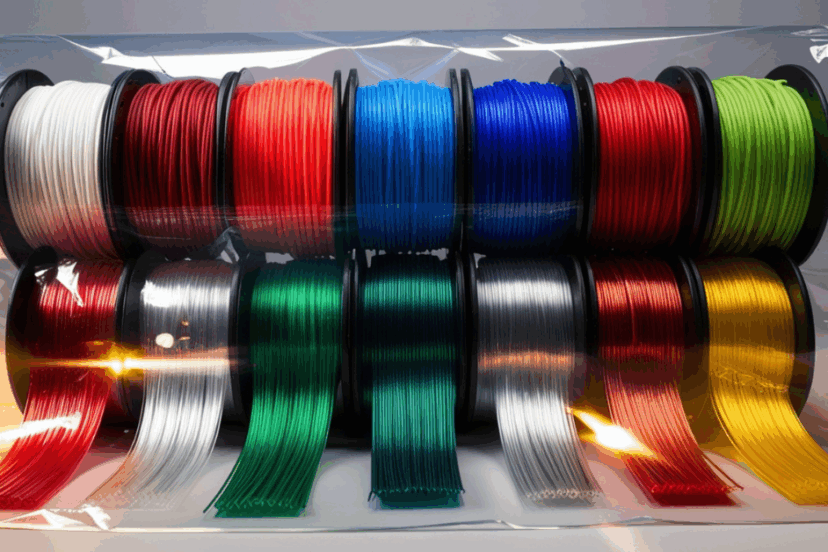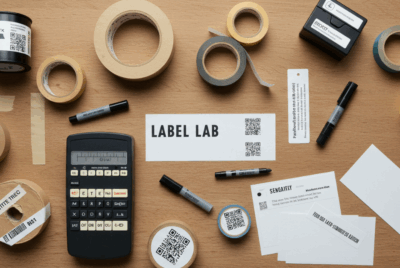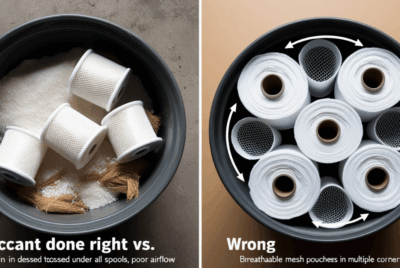What is the Impact of Vacuum-Sealing on Filament Color and Aesthetics?
What is the Impact of Vacuum-Sealing on Filament Color and Aesthetics?
When storing 3D filament, one of the primary concerns is preserving its quality and performance over time. However, many users also want to maintain the color and aesthetic qualities of their filament, especially when using filaments with vibrant hues or special finishes. Vacuum-sealing is an effective way to protect filament from moisture, dust, and UV damage, but how does it impact the color and overall aesthetic of the filament over long periods of storage? Let’s explore the effects of vacuum-sealing on filament color and aesthetics.
1. Protection from UV Damage
What It Means:
UV light is one of the main contributors to the degradation of filament color. Exposure to sunlight or even artificial UV light can cause the filament to fade or change color over time. This is especially noticeable with vibrant colors like red, blue, and green, which are more sensitive to light exposure.
Why It Matters:
Filament that is exposed to UV light for extended periods can lose its brightness and vibrancy, leading to dull or uneven colors. For users working with colorful prints or aesthetic projects, maintaining the filament’s original hue is essential.
How Vacuum-Sealing Helps:
Vacuum-sealing protects filament from direct UV exposure by creating an airtight seal that keeps the filament shielded from light. When stored in a dark place, vacuum-sealed filament remains protected from UV degradation, preserving its color and finish.
Benefit:
Prevents color fading and ensures that your filament retains its original vibrancy and aesthetic appeal even after long periods of storage.
2. Moisture-Related Color Changes
What It Means:
Moisture absorption can also affect the color and finish of filament, particularly in filaments like Nylon, which is highly sensitive to water. When filament absorbs moisture, it can lead to swelling or surface inconsistencies, which may alter its appearance or cause printing defects.
Why It Matters:
Moisture that enters filament can cause surface imperfections, leading to a rougher texture and uneven color distribution. This is especially problematic when working with specialty filaments that rely on smooth, consistent color for a professional finish.
How Vacuum-Sealing Helps:
By removing air and sealing out moisture, vacuum-sealing keeps the filament dry, preventing any moisture-related changes to the filament’s surface and appearance. This helps the filament maintain its original color and smoothness over time.
Benefit:
Preserves the filament’s finish and color consistency, ensuring it remains smooth and ready to print with the desired visual result.
3. Preservation of Specialty Filaments with Unique Finishes
What It Means:
Some filaments come with special finishes such as metallic, glossy, matte, or sparkle effects. These unique aesthetic qualities can be more susceptible to changes in their appearance when exposed to air, moisture, or contaminants.
Why It Matters:
For specialty filaments, any degradation in the finish can result in a less polished or uneven print, which may be unacceptable for projects that rely on visual quality. Metallic or glitter-filled filaments may lose their shine or sparkle if exposed to moisture or improper storage.
How Vacuum-Sealing Helps:
Vacuum-sealing creates a moisture-proof environment that keeps the filament dry and preserves its finish. By preventing exposure to air, vacuum-sealing ensures that metallic, glitter, or matte finishes stay intact, with no alteration to the appearance or texture.
Benefit:
Preserves the integrity of specialty finishes, ensuring that the filament retains its unique aesthetic qualities and is ready for high-quality prints when you need it.
4. Prevention of Filament Contamination
What It Means:
Exposure to dust, dirt, and other contaminants can affect the surface finish and color consistency of the filament. Contaminants can create marks or spots on the filament, leading to uneven prints and poor visual outcomes.
Why It Matters:
For users working with transparent or light-colored filaments, contaminants can be even more noticeable. These imperfections may affect the aesthetic appeal of the print and make it difficult to achieve the desired finish.
How Vacuum-Sealing Helps:
Vacuum-sealing protects filament from external contaminants by sealing it in a clean, airtight environment. With the moisture-proof bag, the filament remains free of dust or debris, ensuring a smooth, pristine appearance when it’s ready for printing.
Benefit:
Keeps filament clean and free from contamination, preserving its visual quality and ensuring a high-quality finish on your prints.
5. Avoiding Filament Brittleness and Surface Issues
What It Means:
Brittleness can occur when filament is exposed to air or moisture over time, causing it to become fragile and prone to breaking during printing. This can negatively affect the surface quality of prints, as the filament may break or snap while extruding, leading to disruptions in the print flow.
Why It Matters:
Filament that becomes brittle due to moisture absorption or exposure to air may not only affect print performance but also cause visible flaws in the final print surface. For filaments with high visual expectations, such as transparent or smooth finishes, brittleness can lead to poor surface quality.
How Vacuum-Sealing Helps:
Vacuum-sealing eliminates the risk of filament becoming brittle by preventing moisture exposure. This allows the filament to remain flexible and strong, maintaining its printability and surface quality over time.
Benefit:
Prevents brittleness and ensures the filament remains strong, flexible, and ready for high-quality prints without surface disruptions.
6. Maintaining Transparency and Glossiness
What It Means:
Filaments with transparent or glossy finishes can lose their clarity and shine when exposed to moisture or air. Over time, moisture can cause the filament to develop a cloudy appearance, which can ruin the visual quality of prints, especially when creating clear parts.
Why It Matters:
For projects where transparency is crucial, such as in light fixtures or clear prototypes, maintaining the clarity and glossiness of the filament is essential. Moisture exposure can lead to cloudiness and loss of clarity in the final print.
How Vacuum-Sealing Helps:
By creating an airtight seal and protecting the filament from exposure to moisture, vacuum-sealing ensures that transparent or glossy filaments retain their original clarity and shine. The sealed bag prevents air and moisture from altering the appearance of the filament.
Benefit:
Preserves transparency and glossiness, ensuring that clear or glossy filaments maintain their visual appeal for high-quality, aesthetically pleasing prints.
7. Vacuum-Sealing and Filament Branding
What It Means:
Many filament manufacturers offer premium-quality filaments with branded packaging and special finishes. While vacuum-sealing helps preserve the filament’s material properties, it may impact the branding and visual appeal of the packaging itself.
Why It Matters:
While vacuum-sealing offers excellent protection for filament, the process may compress or alter the brand packaging on the spool, which could affect its presentation if you plan to showcase or resell the filament.
How Vacuum-Sealing Helps:
For personal use, the material quality of the filament is more important than the packaging. However, if preserving the brand packaging is a concern, consider vacuum-sealing the filament separately from the original packaging or using larger vacuum bags to prevent damage to the packaging.
Benefit:
Preserves filament quality and ensures the aesthetic of the filament’s material is maintained, but consider packaging needs if you’re reselling or showcasing the filament.
Summary of Impact of Vacuum-Sealing on Filament Color and Aesthetics:
| Factor | Impact of Vacuum-Sealing |
|---|---|
| UV Protection | Prevents color fading by blocking UV light exposure. |
| Moisture Protection | Prevents color changes caused by moisture absorption. |
| Specialty Finishes | Preserves the integrity of finishes like metallic, matte, or glossy. |
| Dust and Contaminants | Keeps filament clean, preserving the surface finish. |
| Brittleness | Prevents brittleness, maintaining flexibility and surface quality. |
| Transparency and Gloss | Retains clarity and glossiness, keeping clear and shiny filaments intact. |
| Branding | Preserves material quality but may compress or alter packaging. |
Conclusion:
Vacuum-sealing is highly effective at preserving the color and aesthetic qualities of filament by protecting it from moisture, UV degradation, dust, and contaminants. It helps maintain the vibrancy, smoothness, and unique finishes of the filament, ensuring that the filament performs as expected in terms of both quality and appearance. Whether you’re using transparent, metallic, or glossy filaments, vacuum-sealing provides a reliable storage method to keep your filament in optimal condition for high-quality prints.




